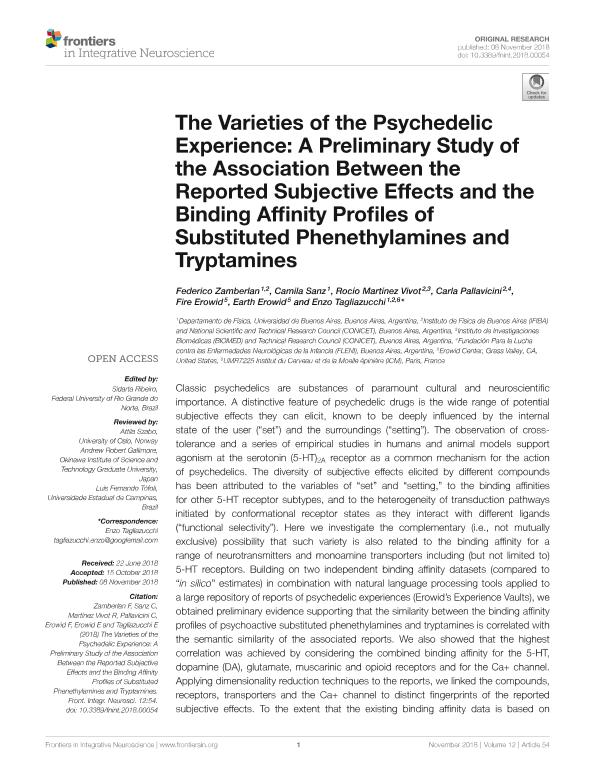Mostrar el registro sencillo del ítem
dc.contributor.author
Zamberlan, Federico

dc.contributor.author
Sanz, Camila

dc.contributor.author
Martínez Vivot, Rocío

dc.contributor.author
Pallavicini, Carla

dc.contributor.author
Erowid, Fire
dc.contributor.author
Erowid, Earth
dc.contributor.author
Tagliazucchi, Enzo Rodolfo

dc.date.available
2020-03-13T12:52:25Z
dc.date.issued
2018-11
dc.identifier.citation
Zamberlan, Federico; Sanz, Camila; Martínez Vivot, Rocío; Pallavicini, Carla; Erowid, Fire; et al.; The varieties of the psychedelic experience: A preliminary study of the association between the reported subjective effects and the binding affinity profiles of substituted phenethylamines and tryptamines; Frontiers Media S.A.; Frontiers in Integrative Neuroscience; 12; 54; 11-2018; 1-22
dc.identifier.issn
1662-5145
dc.identifier.uri
http://hdl.handle.net/11336/99432
dc.description.abstract
Classic psychedelics are substances of paramount cultural and neuroscientific importance. A distinctive feature of psychedelic drugs is the wide range of potential subjective effects they can elicit, known to be deeply influenced by the internal state of the user (“set”) and the surroundings (“setting”). The observation of cross-tolerance and a series of empirical studies in humans and animal models support agonism at the serotonin (5-HT)2A receptor as a common mechanism for the action of psychedelics. The diversity of subjective effects elicited by different compounds has been attributed to the variables of “set” and “setting,” to the binding affinities for other 5-HT receptor subtypes, and to the heterogeneity of transduction pathways initiated by conformational receptor states as they interact with different ligands (“functional selectivity”). Here we investigate the complementary (i.e., not mutually exclusive) possibility that such variety is also related to the binding affinity for a range of neurotransmitters and monoamine transporters including (but not limited to) 5-HT receptors. Building on two independent binding affinity datasets (compared to “in silico” estimates) in combination with natural language processing tools applied to a large repository of reports of psychedelic experiences (Erowid’s Experience Vaults), we obtained preliminary evidence supporting that the similarity between the binding affinity profiles of psychoactive substituted phenethylamines and tryptamines is correlated with the semantic similarity of the associated reports. We also showed that the highest correlation was achieved by considering the combined binding affinity for the 5-HT, dopamine (DA), glutamate, muscarinic and opioid receptors and for the Ca+ channel. Applying dimensionality reduction techniques to the reports, we linked the compounds, receptors, transporters and the Ca+ channel to distinct fingerprints of the reported subjective effects. To the extent that the existing binding affinity data is based on a low number of displacement curves that requires further replication, our analysis produced preliminary evidence consistent with the involvement of different binding sites in the reported subjective effects elicited by psychedelics. Beyond the study of this particular class of drugs, we provide a methodological framework to explore the relationship between the binding affinity profiles and the reported subjective effects of other psychoactive compounds.
dc.format
application/pdf
dc.language.iso
eng
dc.publisher
Frontiers Media S.A.

dc.rights
info:eu-repo/semantics/openAccess
dc.rights.uri
https://creativecommons.org/licenses/by/2.5/ar/
dc.subject
BINDING AFFINITY PROFILE
dc.subject
CONSCIOUSNESS
dc.subject
PHENOMENOLOGY
dc.subject
PSYCHEDELICS
dc.subject
SEMANTIC ANALYSIS
dc.subject.classification
Neurociencias

dc.subject.classification
Medicina Básica

dc.subject.classification
CIENCIAS MÉDICAS Y DE LA SALUD

dc.title
The varieties of the psychedelic experience: A preliminary study of the association between the reported subjective effects and the binding affinity profiles of substituted phenethylamines and tryptamines
dc.type
info:eu-repo/semantics/article
dc.type
info:ar-repo/semantics/artículo
dc.type
info:eu-repo/semantics/publishedVersion
dc.date.updated
2020-03-10T12:22:31Z
dc.journal.volume
12
dc.journal.number
54
dc.journal.pagination
1-22
dc.journal.pais
Suiza

dc.description.fil
Fil: Zamberlan, Federico. Consejo Nacional de Investigaciones Científicas y Técnicas. Oficina de Coordinación Administrativa Ciudad Universitaria. Instituto de Física de Buenos Aires. Universidad de Buenos Aires. Facultad de Ciencias Exactas y Naturales. Instituto de Física de Buenos Aires; Argentina
dc.description.fil
Fil: Sanz, Camila. Consejo Nacional de Investigaciones Científicas y Técnicas; Argentina. Universidad de Buenos Aires; Argentina
dc.description.fil
Fil: Martínez Vivot, Rocío. Consejo Nacional de Investigaciones Científicas y Técnicas. Oficina de Coordinación Administrativa Houssay. Instituto de Investigaciones Biomédicas. Universidad de Buenos Aires. Facultad de Medicina. Instituto de Investigaciones Biomédicas; Argentina. Consejo Nacional de Investigaciones Científicas y Técnicas. Oficina de Coordinación Administrativa Ciudad Universitaria. Instituto de Física de Buenos Aires. Universidad de Buenos Aires. Facultad de Ciencias Exactas y Naturales. Instituto de Física de Buenos Aires; Argentina
dc.description.fil
Fil: Pallavicini, Carla. Consejo Nacional de Investigaciones Científicas y Técnicas. Oficina de Coordinación Administrativa Ciudad Universitaria. Instituto de Física de Buenos Aires. Universidad de Buenos Aires. Facultad de Ciencias Exactas y Naturales. Instituto de Física de Buenos Aires; Argentina. Fundación para la Lucha contra las Enfermedades Neurológicas de la Infancia; Argentina
dc.description.fil
Fil: Erowid, Fire. Grass Valley; Estados Unidos
dc.description.fil
Fil: Erowid, Earth. Grass Valley; Estados Unidos
dc.description.fil
Fil: Tagliazucchi, Enzo Rodolfo. Institut du cerveau et de la moelle épinière; Francia. Consejo Nacional de Investigaciones Científicas y Técnicas. Oficina de Coordinación Administrativa Ciudad Universitaria. Instituto de Física de Buenos Aires. Universidad de Buenos Aires. Facultad de Ciencias Exactas y Naturales. Instituto de Física de Buenos Aires; Argentina
dc.journal.title
Frontiers in Integrative Neuroscience
dc.relation.alternativeid
info:eu-repo/semantics/altIdentifier/url/https://www.frontiersin.org/articles/10.3389/fnint.2018.00054/full
dc.relation.alternativeid
info:eu-repo/semantics/altIdentifier/doi/https://doi.org/10.3389/fnint.2018.00054
Archivos asociados
